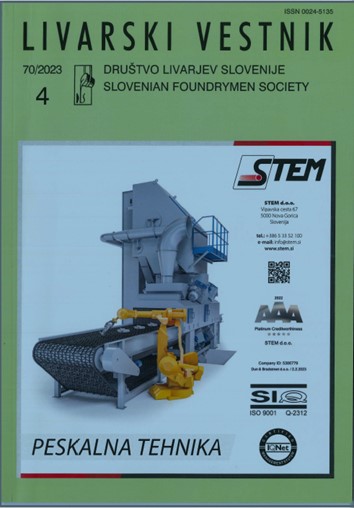|
|
1.H. Polzin, T. Kooyers: IZKUŠNJE S TERMIČNIM STRJEVANJEM ANORGANSKIH VEZIV ZA FORME 2.M. Manapuram: PREOBLIKOVANJE LIVARSKIH POSTOPKOV GLEDE NA UPRAVLJANJE VHODA- IZHODA DOBAVNE VERIGE 3.I. Jandrlić, F. Kozina, T. Brlić, L. Mrkobrada: SPREMEMBE STRUKTURE IN LASTNOSTI BAKRENE ŽICE MED PROIZVODNJO IN PREDELAVO 4.M. Mencej: ČASOVNO UČINKOVITA ANALIZA TEHNIČNE ČISTOSTI Z MIKROSKOPOM |
1.
H. Polzin, T. Kooyers:
IZKUŠNJE S TERMIČNIM STRJEVANJEM ANORGANSKIH VEZIV ZA FORME
Povzetek
Ta prispevek opisuje postopek izdelave jeder iz anorganskih veziv in sušenja z vročim zrakom, ki smo ga že predstavili na predhodnih dogodkih in v katerem uporaba aktivno ogrevanega orodja za izdelavo jedra ni potrebna. [1] S pomočjo tega sistema smo imeli v zadnjem času več pozitivnih izkušenj. Predstavljene so lastnosti spojin za forme, proizvedene z vezivom, na primer dosegljive trdnosti pri različnih pogojih strjevanja ali preostale napetosti po litju ulitkov. Čeprav je bil sistem razvit posebej za livarne, ki se ukvarjajo z litjem železa ali jekla, so prikazani primeri jeder tako iz sektorja železovih litin kot sektorja neželezovih kovin. Čeprav je bilo vezivo prvotno razvito za utrjevanje formatski materialov z vročim zrakom pri približno 160 °C, se lahko sistem brez tega uporablja tudi s katerim koli jedrovnikom z ogrevanim jeklenim jedrovnikom. Predstavljeno anorgansko vezivo na osnovi vodnega stekla predstavlja alternativo postopku PUR Coldbox, ki ga je mogoče uporabljati pri litju železa in jekla. V primerjavi s podobnimi vezivi se odmeri manjša količina enokomponentnega veziva; količine veziv, uporabljene do sedaj, merijo med 1,5 % in 2,5 %, vendar jih je mogoče po potrebi tudi povečati. Enokomponentni sistem poenostavi odmerjanje veziva v napravo za proizvodnjo jeder, želene trdnosti pa se zagotovijo skozi primerljivo večje specifične trdnosti. Sušenje proizvedenih jeder poteka s toplim zrakom za prepihovanje pri temperaturi 160 °C. Orodje za izdelavo jedra se med postopkom ne greje. Pri izbiri materiala za jedrovnik je treba zagotoviti uporabo plastike z ustrezno toplotno odpornostjo. Kovinski (aluminijasti ali jekleni) jedrovniki zagotavljajo prednosti v smislu krajšega časa cikla. V primeru uporabe izredno suhega zraka lahko utrjevanje poteka pri nižjih temperaturah. Vezivo se lahko seveda uporablja tako v postopkih Warmbox kot Hotbox. Dejstvo, da se nastanek razpok v jedriozni pojavi samo v izjemnih primerih pri jedrih z anorganskimi vezivi, je zagotovo dobrodošla prednost v komori za prepihovanje. Preostala trdnost ter obnašanje pri odstranjevanju jedra sta zelo podobna kot pri postopku PUR Coldbox. Poleg veziv, zasnovanih za železne in jeklene ulitke, so na voljo tudi različice za aluminijaste ali bakrene ulitke.
2.
M. Manapuram:
PREOBLIKOVANJE LIVARSKIH POSTOPKOV GLEDE NA UPRAVLJANJE VHODA- IZHODA DOBAVNE VERIGE
Izvleček
Svetovna populacija je glede na merilnik Worldometer v juniju 2022 narasla na 8 milijard. Po podatkih svetovnega popisa livarn iz leta 2021 je Indija drugi največji proizvajalec ulitkov (11,31 milijona ton v 4.500 livarnah) na svetu. Svetovna letna proizvodnja ulitkov je v letu 2021 znašala 105,5 milijona ton v več kot 46.500 livarnah v 34 državah. Livarne se glede na naravo dela na splošno razvrščajo na vezane livarne (sestavni deli organizacij, za katere izdelujejo ulitke), uslužnostne livarne (izdelujejo manjše število ulitkov za različne stranke), proizvodne livarne (gospodarna proizvodnja ulitkov v velikem obsegu) in polproizvodne livarne (kombinacija proizvodne in uslužnostne livarne). Livarstvo potrebuje velike količine vhodnih surovin in proizvaja ulitke za različne uporabniške panoge na kopnem, v morju in zraku, kot so avtomobilska industrija, strojna orodja, železnica, letalstvo in pomorska industrija. Vhodni-izhodni model ulitkov in upravljanje dobavne verige sta za livarsko industrijo bistvenega pomena. Nove tehnologije, npr. električna vozila, aditivna proizvodnja itd. predstavljajo nove težave za obstoječe livarje. Da bi zadostili spreminjajočim se razmeram, morajo livarji in lastniki livarn preoblikovati svoje postopke litja. Zato smo v tem prispevku opravili poskus preoblikovanja postopkov litja, primernih za hibridna električna vozila, 3-D tiskanje ulitkov itd. in sistemov za upravljanje dobavne verige, ki so potrebni za zahtevane vhodne surovine in izhodne proizvedene ulitke.
Ključne besede: litje, upravljanje dobavne verige, svetovni popis livarn, Worldometer, 3-D tiskanje
3.
I. Jandrlić, F. Kozina, T. Brlić, L. Mrkobrada:
SPREMEMBE STRUKTURE IN LASTNOSTI BAKRENE ŽICE MED PROIZVODNJO IN PREDELAVO
Povzetek
Kot prevodnik električne energije je baker še vedno nenadomestljiv, zato je dandanes še vedno najpomembnejša barvna kovina v uporabi. Najpogosteje uporabljene metode za proizvodnjo bakrenih vodnikov vključujejo kontinuirno litje bakrene žice, naknadno deformacijo s hladnim vlečenjem in postopke toplotne obdelave za izboljšanje mehanskih in električnih lastnosti bakra. V tem prispevku je bila opravljena raziskava bakrene žice, proizvedene z kontinuirnim litjem. Med proizvodnjo pride do različnih strukturnih sprememb kot tudi sprememb mehanskih lastnosti. Da bi raziskali te spremembe in pojasnili njihov vpliv na končni izdelek, smo v vseh fazah proizvodnje beležili in merili strukturo in trdoto bakrene žice. Makrostrukturo in mikrostrukturo smo opazovali s svetlobnim mikroskopom, trdoto pa smo izmerili z Vickersovo metodo za merjenje trdote. Rezultati kažejo, da se začetna grobozrnata struktura v litem stanju med redukcijo razgradi v drobnozrnato strukturo. Ta drobna zrna so med plastično deformacijo usmerjena v smeri hladnega vleka. Trdota se poveča. Namen toplotne obdelave je zagotoviti boljšo prevodnost in hkrati ohraniti dobre mehanske lastnosti. Rezultati analize mikrostrukture kažejo na prisotnost dvojčkov kristalov v strukturi končnega izdelka.
Ključne besede: bakrena žica, hladno vlečenje, dvojčični kristali, struktura, trdota
4.
M. Mencej:
ČASOVNO UČINKOVITA ANALIZA TEHNIČNE ČISTOSTI Z MIKROSKOPOM
Povzetek
Analiza tehnične čistosti postaja vse pomembnejša v industrijski proizvodnji. Tako sami proizvajalci komponent, kot tudi kupci komponent zahtevajo podrobne analize preostalih nečistosti na površini proizvodov. Osnovna standarda, ki se pojavljata pri analizah komponent sta VDA 19.1 in ISO 16232. Za področje medicinske opreme in olja pa so na voljo še drugi standardi.
Osnovne analize lahko opravljamo s svetlobnimi mikroskopi. Le ti omogočajo klasifikacijo po velikosti in obliki, ter razločevanje med reflektirajočimi in nerefliktirajočimi nečistočami. Za podrobno analizo kemijske sestave nečistoč pa potrebujemo elektronski mikroskop.
ZEISS nudi rešitve tako na področju svetlobne, kakor tudi elektronske mikroskopije. Prav tako imamo tudi rešitve na področju korelativne mikroskopije, ki povezuje svetlobne z elektronskimi mikroskopi.
Ključne besede: analiza tehnične čistosti, svetlobna mikroskopija, elektronska mikroskopija, vgrajena polarizacija, standardi VDA 19.1 in ISO 16232.




